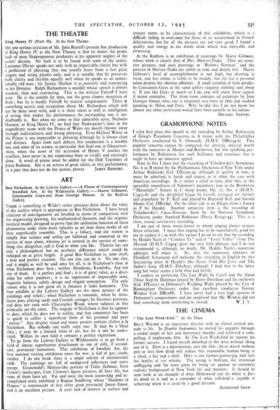ART
Ben Nicholson. At the Lefevre Gallery.—A Phase of Contemporary Swedish Art. At the Wildenstein Gallery.—Maeve Gilmore, Constantin Guys and Jean George Simon. At the Redfern Gallery.
THERE is something in Wilde's rather precious dicta about the value of the useless which is appropriate to Ben Nicholson. I have heard criticism of-non-figurative art levelled in terms of comparison with the engineering drawing, the mathematical theorem, and the trigono- metrical model, designed to prove that the utilitarian function of these phenomena make them more valuable as art than those works of art they superficially resemble. This is a fallacy, and the reason is simply that science and utility are followed and contrived in the service of man alone, whereas art is created in the service of some- thing else altogether, call it God or what you like. Therein lies not only a philosophical but an aesthetic difference which could be enlarged on at great length. A good Ben Nicholson is, unto itself, a true and perfect creation. No one else can do it. I■lo one else, and it might as well be said once for all, is in Nicholson's class at what Nicholson does best ; neither Mondrian, Kandisky, Arp nor any of them. It is perfect and final ; it is of great value, as a disci- pline for other painters; it is an expression of impeccable taste, exquisite balance, subtle design and elegant conception. The only reason why it is not great art is because it lacks humanity. The best exhibits at the Lefevre Gallery are the most austere of the paintings and reliefs ; when Nicholson is romantic, when he intro- duces pots, playing cards and Cornish cottages, he becomes precious, and does not rank with Christopher Wood, whose subjects in this particular are the same. The tragedy of Nicholson is that he appears to date, which he does not in reality, and that commerce has been so quick to utilise a superficial form of his personal and pure " métier." Any display stand and many posters contain cliches a la Nicholson. But nobody can really copy one. It may be a blind alley ; it may be a limited form of art, but let it not be under- rated. Within its own field it remains a perfect expression.
To go from the Lefevre Gallery to Wildensteins is to go from a field of almost superhuman detachment to one of jolly, if second- rate, provincial humanism. This exhibition of Swedish Art, the first national visiting exhibition since the war, is full of gay, crude, vitality. I do not think there is a single exhibit of international rank. The paintings are full of undigested influences and naive energy. Grunewald's Matisse-like portrait of Tollie Zellman, Sven Erixon's landscapes, Curt Clemen's figure pictures, all have life, but none of them have art. Far and away the most interesting and ac- complished artist exhibited is Ragnar Sandberg, whose ' Shadows of Houses' is reminiscent of that other great provincial James Ensor, and is an excellent picture. A total lack of interest in surface and texture seems to be characteristic of this exhibition, which is a difficult failing to overcome for those of us accustomed to French delectations, but for all the pictures are not very good, I found a quality and energy in the whole show which was enjoyable and promising.
At the Redfern is an exhibition of paintings by Maeve Gilmore, whose work is clearly that of Mrs. Mervyn Peake. They are sensi- tive pictures, and such paintings as ' Barbara Norman ' and the portrait of Mervyn Peake are subtle in tone and deeply felt. 1Viaeve Gilmore's level of accomplishment is not high, her drawing is weak, and her colour is liable to be muddy, but she has a personal talent despite her obvious affinities. A small roomful of little doodles by Constantin Guys at the same gallery requires nothing said about it. If you like Guys as much as I do, you will enjoy these typical if minor examples. The front room contains oil paintings by Jean Georges Simon, who, one is informed, was born in 1892 and studied painting in Milan and Paris. Why he did this I do not know for almost any other profession would have been suitable to his talents.
MICHAEL AYRTON.


























 Previous page
Previous page